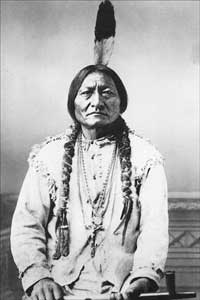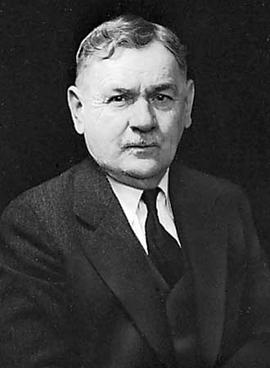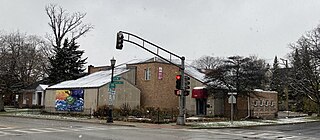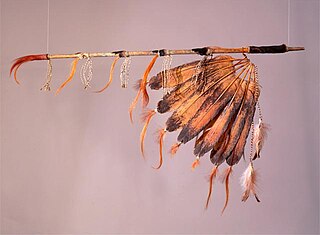
The Lakota are a Native American people. Also known as the Teton Sioux, they are one of the three prominent subcultures of the Sioux people, with the Eastern Dakota (Santee) and Western Dakota (Wičhíyena). Their current lands are in North and South Dakota. They speak Lakȟótiyapi—the Lakota language, the westernmost of three closely related languages that belong to the Siouan language family.

The Sioux or Oceti Sakowin are groups of Native American tribes and First Nations people from the Great Plains of North America. The Sioux have two major linguistic divisions: the Dakota and Lakota peoples. Collectively, they are the Očhéthi Šakówiŋ, or "Seven Council Fires". The term "Sioux", an exonym from a French transcription ("Nadouessioux") of the Ojibwe term "Nadowessi", can refer to any ethnic group within the Great Sioux Nation or to any of the nation's many language dialects.

A tipi or tepee is a conical lodge tent that is distinguished from other conical tents by the smoke flaps at the top of the structure, and historically made of animal hides or pelts or, in more recent generations, of canvas stretched on a framework of wooden poles. The loanword came into English usage from the Dakota language and Lakota language.

Clark David Wissler was an American anthropologist, ethnologist, and archaeologist.

Pipestone National Monument is located in southwestern Minnesota, just north of the city of Pipestone, Minnesota. It is located along the highways of U.S. Route 75, Minnesota State Highway 23 and Minnesota State Highway 30. The quarries are culturally significant to 23 tribal nations of North America. Those known to actually occupied the site chronologically are the Yankton Dakota, Iowa, and Omaha peoples. The Quarries were considered a neutral territory in the historic past where all tribal nations could quarry stone for ceremonial pipes. The catlinite, or "pipestone", is traditionally used to make ceremonial pipes. They are vitally important to Plains Indian traditional practices. Archeologists believe the site has been in use for over 3000 years with Minnesota pipestone having been found in ancient North American burial mounds across a large geographic area.

Quillwork is a form of textile embellishment traditionally practiced by Indigenous peoples of North America that employs the quills of porcupines as an aesthetic element. Quills from bird feathers were also occasionally used in quillwork.
Chanunpa is the Lakota language name for the sacred, ceremonial pipe and the ceremony in which it is used. The pipe ceremony is one of the Seven Sacred Rites of the Lakota people. Lakota tradition has it that White Buffalo Calf Woman brought the chanunpa to the people, as one of the Seven Sacred Rites, to serve as a sacred bridge between this world and Wakan Tanka, the "Great Mystery".

The Mitchell Museum of the American Indian is a museum in Evanston, Illinois that focuses exclusively on the history, culture and arts of North American native peoples. It is a Core Member of the Chicago Cultural Alliance, a consortium of 25 ethnic museums and cultural centres in Chicago.

A hair drop is an ornament worn by men from Great Lakes and Plains tribes. It would be tied to the man's hair. The typical example consists of a quilled or beaded section on a strip of leather, which was later attached to an American buffalo tail. They could be over two feet long.

The Oglala are one of the seven subtribes of the Lakota people who, along with the Dakota, make up the Očhéthi Šakówiŋ. A majority of the Oglala live on the Pine Ridge Indian Reservation in South Dakota, the eighth-largest Native American reservation in the United States.

A bandolier bag is a Native American shoulder pouch, often beaded. Early examples were made from pelts, twined fabrics, or hide, but beginning in the fur trade era, Native American women stitched bags of imported wool broadcloth, lined with cotton calico and often edged with silk ribbons.

Juanita Growing Thunder Fogarty is a Native American, Assiniboine Sioux bead worker and porcupine quill worker. She creates traditional Northern Plains regalia.
There are a vast array of myths surrounding the Blackfoot Native Americans as well as Aboriginal people. The Blackfeet inhabit the Great Plains, in the areas known as Alberta, Saskatchewan, and areas of Montana. These stories, myths, origins, and legends play a big role in their everyday life, such as their religion, their history, and their beliefs. Only the elders of the Blackfoot tribes are allowed to tell the tales, and are typically difficult to obtain because the elders of the tribes are often reluctant to tell them to strangers who are not of the tribe. People such as George B. Grinnell, John Maclean, D.C. Duvall, Clark Wissler, and James Willard Schultz were able to obtain and record a number of the stories that are told by the tribes.

Native American jewelry refers to items of personal adornment, whether for personal use, sale or as art; examples of which include necklaces, earrings, bracelets, rings and pins, as well as ketohs, wampum, and labrets, made by one of the Indigenous peoples of the United States. Native American jewelry normally reflects the cultural diversity and history of its makers, but tribal groups have often borrowed and copied designs and methods from other, neighboring tribes or nations with which they had trade, and this practice continues today. Native American tribes continue to develop distinct aesthetics rooted in their personal artistic visions and cultural traditions. Artists may create jewelry for adornment, ceremonies, and display, or for sale or trade. Lois Sherr Dubin writes, "[i]n the absence of written languages, adornment became an important element of Indian communication, conveying many levels of information." Later, jewelry and personal adornment "...signaled resistance to assimilation. It remains a major statement of tribal and individual identity."

A ceremonial pipe is a particular type of smoking pipe, used by a number of cultures of the indigenous peoples of the Americas in their sacred ceremonies. Traditionally they are used to offer prayers in a religious ceremony, to make a ceremonial commitment, or to seal a covenant or treaty. The pipe ceremony may be a component of a larger ceremony, or held as a sacred ceremony in and of itself. Indigenous peoples of the Americas who use ceremonial pipes have names for them in each culture's Indigenous language. Not all cultures have pipe traditions, and there is no single word for all ceremonial pipes across the hundreds of diverse Native American languages.

The Buffalo Dance, or Bison Dance, is an annual dance festival of many North American Plains Natives, including the Mandan, Sioux, Cheyenne, Pawnee, and Omaha, among others. The festival traditionally coincided with the return of the buffalo herds, and included a feast and a dance with a number of men wearing buffalo and other animal skins.

Emily Waheneka (1919-2008) was a Native American artist, of Warm Springs, Wasco and Paiute tribal heritage.

Alice Blue Legs was a Lakota Sioux craftworker, notable for her quillwork. She received a 1985 National Heritage Fellowship from the National Endowment for the Arts and was a featured artist for the documentary film Lakota Quillwork—Art and Legend. Her work was seen in the epic film Dances with Wolves and exhibited in museums such as The Children's Museum of Indianapolis, the Heard Museum, the Sioux Indian Museum. Examples of her work are in the permanent collection of the Indian Arts and Crafts Board at the Washington, D. C. headquarters of the United States Department of the Interior and the Smithsonian's National Museum of the American Indian.

Joyce Growing Thunder Fogarty, is a Native American artist. She is of the Assiniboine Sioux, Dakota people, and is known for her beadwork and quillwork. She creates traditional Northern Plains regalia. The Smithsonian named her as "one of the West's most highly regarded beadworkers".

Jaw/Ćehu'pa, also known as His Fight/Oki'cize-ta'wa, was a Hunkpapa (Húŋkpapȟa) Lakota Winter count keeper and Ledger art artist


















